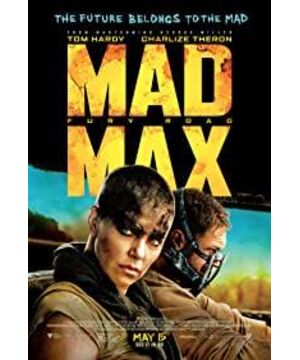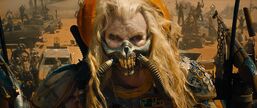As early as 1981's "Mad Max 2", director George Miller has successfully merged elements such as road movies and doomsday movies, creating new styles or genres, and experimenting with new ways of transforming vehicles (before the first episode of the film). "Mad Max", has not yet established the world view of Doom/Wasteland). Its script should have been inspired by Akira Kurosawa's films. For example, at the beginning, Max went to rescue the defenders of the oil tribe in exchange for scarce fuel. Later, he disregarded his own interests and broke through the siege of the Humungus group with everyone. With the shadow of the story of "Seven Samurai", the samurai and the peasant from friction, running-in, and then working together to resist the bandit (Max's image in this episode is also with Kikuchiyo played by Toshiro Mifune - this seems to be an anti-samurai. Spirit, but in essence a character whose character contrasts sharply with his outwardly rambunctious character, somewhat similar).
In 2015's "Mad Max: Fury Road", Max went through the process of running away from himself to being willing to sacrifice for his companions (running alone to blow up the car of The Bullet Farmer, which has lost his mind). Director George Miller inherited the previous work, modernizing the road and westerns (such as Sergio Leone's "correction" of traditional westerns), so that in old westerns, Indians often stand on high ground to monitor the image of the enemy below, becoming A picture of people riding motorcycles on the canyon and monitoring the protagonists. Some commentators have also pointed out, "The post-apocalyptic highway represents not just a scene of a long-distance pursuit, but a medium for character development, social presentation or gender issues, and political intervention; Stagecoach has the same depth, all in a very dangerous situation, bringing together a lot of different people and then causing them to fail and grow."
Mad Max, played by Mel Gibson, promised Aunty Entity in the third episode that he would kill Master's strong partner Blaster in the arena where only "two people enter and one person leaves"; but when Mad Max planned to When he killed the opponent with a mallet, he discovered that the real face under Blaster's helmet turned out to be a person with a developmental disability and a child-like mind, so he couldn't bear to kill him. The bridge section that violated the original promise is also reflected in "Mad Max: Fury Road": the heroine Furiosa originally promised that the motorcycle party on the canyon would only come by herself, and exchanged gasoline to let it pass; but in fact However, she took several of Immortan Joe's wives and concubines "seedmothers" and fled together. This film uses Furiosa's violation of the contractual spirit valued by the Western world to show some principles that she must give up in order to survive in the collapsed world, but Furiosa is willing to risk "fouling" and violate the promise. Because of the rescue of Immortan Joe's several wives and concubines, the "seed mother", this further highlights her human nature like Mad Max in the third episode.
Director George Miller is good at expressing the rich inner activities of the characters with the pictures of the film, the neat movements, and the concise dialogue. In the section where the bikers on the mountain chased the armed transporter, when Furiosa asked Immortan Joe's most beloved "seed mother" Angharad to help load the bullet, Angharad hesitated at first, and simply responded with I CANT to express She should be very decisive (even after being injured by Max on the calf, she still does not turn her head and walks forward), because she does not want to kill (when I contacted Furiosa before to solve the "War Boy" Nux, Angharad strongly discouraged her. A scene), which triggered an inner struggle (see the picture below); followed by Knowing (another concubine of Immortan Joe's "seed mother"), grabbing the gun and letting her load the bullet, and her determined look back at Angharad The look, again, reflects her tough character, and is reflected again in her courageous performance at the end of the return battle (Knowing stops Immortan Joe from firing at Furiosa).
Many reviews will mention that Mad Max: Fury Road is a feminist film that not only portrays the gritty and dominant role of Furiosa (who is more important in the film than Max) Even the "seed mothers" who are mistaken for "vases" when they appear on the stage appear to be flesh and blood and have a certain "thickness". In this film, they try their best to resist and get rid of Immortan Joe's control, and these female characters also get rid of the setting of traditional action movies, and will not just become "accessories" in the play. "Mad Max: Fury Road", which is so strong, hot, and continues the savage futurism or Punk style of the previous work, not only shows the women's tenacity and women's indomitable style, but also shows their tenderness and compassion ( Like Capable's willingness to listen to the inner scene of "War Boy" Nux), or the characteristics that will breed. These flesh-and-blood female characters are as rare in action movies as the old female warrior Melissa Jaffer, carrying various seeds in the desert; and their uncompromisingness is like the "symbol of the seed". ” symbolizes the continuation of hope (watch out for the appearance of the seed, just after the hope of the “oasis” has been dashed).
At the beginning of the movie "Mad Max: Fury Road", it was said that "survival" is Max's only remaining belief. We will see later that the characters in the film will work hard for different beliefs or realize themselves. the value of. These beliefs are so powerful that Angharad ignores her despite being shot in the calf by a bullet; so powerful that after all the hard work they have escaped from Immortan Joe's clutches, they are still willing to go back to their new "oasis" in their hearts Turn back; even if the goal pursued is the opposite of Max's "War Boy" (Max pursues survival, "War Boy" hopes to make himself enter the Hall of Valor through "heroic sacrifice"), they are more persistent in sticking to it With the belief in my heart, it seems difficult to shake (one of the things I regret about this film is that the transformation of "War Boy" Nux is still too sudden). In this film, "faith" is like a V8 engine that drives the protagonists forward; and in this film, Max is constantly haunted by people who he failed to protect, or who gave them false hope, and felt that "hope" Things can harm people; but later, he and the female characters around him have lost hope (the "oasis" has been destroyed) and gained new hope (in fact, the "oasis" is where he escaped); this is like The little girl entangled in Max's heart also leads Max to be so two-sided. Their "hope" or beliefs can "harm people" and disappoint people, but they can also bring salvation to the protagonists.
Audiences who have watched the first and third episodes of "Mad Max" should remember Max's wife and the blind man in Bartertown playing the Saxophone; in the fourth episode, there is an even more amazing flame guitar player The Doof Warrior arrives and inspires Immortan Joe's army into battle. In addition to the protagonist, child character, dwarf, V8, fuel tanker, and the aesthetic tone of the wasteland, this film also inherits many elements of the previous film, such as a dumb shotgun, Music Box, a big iron hook, a monocular, There is also the director's "worship" of old female warriors, which has already been seen in the first episode (the mother-in-law with a shotgun); and in the second episode, the villain tied people to the front of the car, and the design like the bow of a boat was also used by "Fury" Road" continued; the image of "War Boy" in this film is very similar to the child with "panda eyes" in the third episode; and with a mask and respirator, it is a bit like the "Star Wars" Darth Vader Immortan Joe, who is played by the same person who played the villain Toecutter in the first episode!
Director George Miller arranged/created a lot of interesting scenes in this film: for example, a shot that appeared after a sandstorm would make you think it was a sand dune, but the most prominent part turned out to be Max being covered by sand and dust head (see above). In addition, in the final stage, when Furiosa and the others returned to the nest in victory and climbed up the mountain on the lift platform, Max walked back under the platform without knowing it and glanced at Furiosa who was at a high place; these shots , the picture suggests Max's identity as an outsider himself. He and Furiosa exchanged eye contact instead of thousands of words. This way of dealing with it can be said to be more silent than sound.
British film critic Robbie Collin once wrote in his review of "Fury Road" : The idea of the film's chase is influenced by Buster Keaton's great work "The General, 1927"; and Anthony Lane also mentioned that the book The action of the people hanging on the end of the long rod, bouncing from one car to another, can be said to be derived from Buster Keaton's "Three Ages, 1923" (of course, those action designs may also be derived from pirate movies. ). In "Mad Max: Fury Road", different angles of view often appear, such as looking down from the top, or looking up from the bottom; and the camera lens in the film sometimes sticks to the back of the head To shoot a long shot, sometimes suddenly approaching, and sometimes zooming back from a medium shot to switch to a long shot. Such flexible use of lenses, combined with the compositional idea of white space and symmetry, enriches the image/picture of this film, and also makes the action scenes in the film more realistic.
George Miller, who is old but crazier than Max, was able to "set things right" and return to the aftermath of making the second half of episode 3 of "Mad Max" into a children's/teenage movie like "The Goonies". On the road that Mad Max 2 drives. In his "Fury Road", there is no clichéd hero and heroine flirting and flirting, nor is it adjusted with innocuous jokes. He tries his best to present real scenes such as rollovers, crashes, explosions, etc. This film uses pictures to speak and actions to speak, which not only brings us a continuous audio-visual enjoyment of climax, but also shows the soul that has been lost in many action films.
View more about Mad Max: Fury Road reviews











